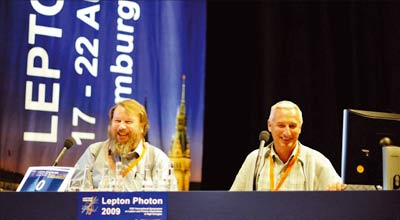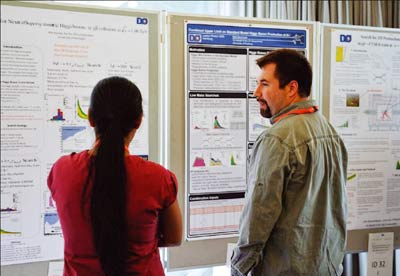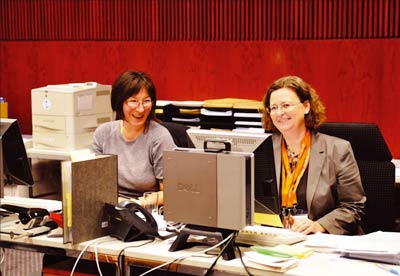The biennial conference provided its usual comprehensive review of particle physics.

Image credit: DESY.
The first time that the International Symposium of Lepton and Photon Interactions at High Energies took place in Hamburg, in 1965, it was in its earlier incarnation that referred to electrons, rather than all leptons. The DESY electron synchrotron had started up the previous year, so the young laboratory was an obvious host for a conference that was relatively specialized. Since then, high-energy electrons have revealed the reality of quarks and the complex nature of the proton; muons have provided signatures of new states of matter, from charmonium to quark–gluon plasma; neutrinos from beyond the Earth have given glimpses of physics beyond the Standard Model; and photons have begun to offer a new view of the high-energy universe. “Lepton Photon” has thus grown to encompass all of particle physics and the 24th symposium, held in Hamburg during DESY’s 50th anniversary year, was no exception.
Within its standard format of invited plenary sessions only, Lepton Photon 2009 presented a clear and concise overview of particle physics today. Expectations for the future formed a recurrent theme, not only in view of the imminent start-up of the LHC but also looking to upgrades, new experiments and facilities to push frontiers in energy and luminosity. This report will focus mainly on recent results presented at the conference in topics varying from QCD and heavy ions to neutrinos and dark matter.
When originally planned, it was likely that this conference would be dominated by the first collisions at the LHC. This news should now fall to the summer conferences in 2010, but the LHC still loomed large in the presentations at Lepton Photon 2009. The first scientific session heard the latest news about the steady progress towards the restart, following the incident of September 2008. The four major experiments, ALICE, ATLAS, CMS and LHCb, took advantage of the prolonged shutdown to complete installation work, implement improvements and make thorough tests with cosmic rays – efforts that led to a highly successful restart in November and December last year.
HERA’s harvest

Image credit: DESY.
The harvest of data from HERA – the world’s only electron–proton collider, which ran from 1992 until 2007 – continues to paint a remarkably clear picture of the internal workings of the proton within the context of QCD, the theory of the strong force. The precision that comes from combining HERA-I data (1996–2000) from the H1 and ZEUS experiments yields impressively accurate distribution functions for the gluons and the quark–antiquark sea in the latest QCD analysis at next-to-leading order (NLO), especially at low values of the momentum fraction. Both H1 and ZEUS have made the first measurements of the structure function, FL, at low x and there are also new results from ZEUS with improved precision at high values of momentum-transfer-squared (high Q2).
The HERMES collaboration at HERA took a different approach by observing the collisions of the electron beam with a gas target. The analysis of kaon production from deuterons indicates that the density of strange quarks – present in the quark–antiquark sea in protons and neutrons – varies differently with x than does that of the sea of lighter quarks. H1, meanwhile, has new measurements for charm and bottom quarks, which agree with QCD analyses.
The main aim of HERMES was to learn more about contributions to the nucleon’s spin, the goal also of COMPASS at CERN (using muons), fixed-target experiments with electrons at Jefferson Lab and polarized proton–proton collisions at RHIC at Brookhaven. Results from these studies have fed the first global NLO QCD analyses of both polarized deep-inelastic lepton–nucleon and proton–proton scattering. The results reinforce the puzzling discovery that the quarks and antiquarks contribute only 25–35% of the nucleon’s spin. They also indicate a large negative contribution from the strange quark at low x, with small contributions so far from the gluon, derived for the first time from the polarized proton–proton data, but subject to large uncertainties.
A fuller view

Image credit: DESY.
While parton distribution functions (PDFs) give a picture of the momentum fraction carried by the constituents in a nucleon, generalized PDFs (GPDFs) give a fuller view that includes information on longitudinal and transverse momentum, which should allow the contribution of orbital angular momentum to the nucleon’s spin to be derived. GPDFs can be extracted from measurements of deeply virtual Compton scattering. The e1-dvcs experiment with the CLAS detector at Jefferson Lab has made an extensive set of high-quality measurements of the beam-spin asymmetry, which will constrain the GPDFs. Also at Jefferson Lab and elsewhere, experiments have studied transversity, which gives a measure of helicity-flip. Last summer the HERMES collaboration reported clear evidence for a non-zero “Sivers effect” in semi-inclusive deep-inelastic scattering from a transversely polarized target, which suggests a non-zero orbital angular momentum for the quarks in a nucleon. A recent fit to data from both HERMES and COMPASS to determine the Sivers function indicates that the orbital angular momentum is mainly from the valence quarks.
Fermilab’s Tevatron continues its Run II, which began in 2001, with proton–antiproton collisions at a total energy of 1.96 TeV. Here the study of jets of particles reveals the hard scattering of the quarks. The DØ collaboration has now measured the angular distribution of pairs of jets (dijets) at 1.96 TeV collision energy, for dijet masses ranging from 0.25 TeV to more than 1.1 TeV – in effect, the first “Rutherford” experiment to go above 1 TeV, a century after Hans Geiger and Ernest Marsden published their results on alpha-particle scattering, which gave the first evidence for Rutherford scattering. This sets the most stringent limits to date on the scale for quark structure, Λ> 2.9 GeV, and also on the scale of extra dimensions.
The large amounts of data accumulated in Run II provide a major test-bed for QCD and an important hunting ground for new particles and new physics. By the time of the conference, the collider had delivered 7 fb–1 and the collaborations had analysed 2.7 fb–1. The CDF and DØ experiments have high-precision results that agree well with NLO perturbative QCD for inclusive jets and dijets, setting limits on new particles with masses up to more than 1.2 TeV. By contrast, there are discrepancies that are still to be understood in the production of isolated photons.

Image credit: DESY.
While results such as these from HERA and the Tevatron continue to consolidate QCD, there has also been impressive theoretical progress in making more precise predictions, in particular in higher-order calculations in readiness for the LHC. Leading-order calculations are already automated and are beginning to include more final-state particles, as in 2→6 body. There are important breakthroughs at NLO, with the first calculation of a 2→4 body cross-section, qqı→ttıbbı, in 2008 and developments in automation, for example in calculating W+3 jets, in 2009. These are important for estimating backgrounds to searches at the LHC. At next-to-NLO, there is progress in calculations on processes that will provide “standard candles” at the LHC.
At the same time, lattice QCD is moving from simulation to the calculation of real physical quantities, a quarter of a century after its invention. Improved algorithms with light quarks have led to new results on the hadron spectrum, with masses agreeing well with experiment. Contributions to flavour physics are also progressing with improved inputs for the Cabibbo–Kobayashi–Maskawa (CKM) matrix. A steady increase in computing power, to the petaflop scale, should lead to further improvements through simulations with smaller spacings (from 0.1 to 0.05 fm) on larger volumes (3–6 fm scale), which will be better suited for studies of QCD in hot, dense matter.
The ultimate test for QCD lies arguably in the hot and dense matter that forms in relativistic heavy-ion collisions and in determining its equation of state and bulk thermodynamic properties. Lattice QCD provides access to this extreme state through simulation, while RHIC at Brookhaven has been the main scene for such studies since 2000. The elliptical flow observed at RHIC is consistent with a phase transition – and this is what recent lattice QCD simulations also clearly indicate. It is also consistent with the formation of an almost perfect fluid, with a ratio of viscosity-to-entropy-density almost 10 times lower than in superfluid helium. Intriguing puzzles remain, however. The BRAHMS and PHOBOS experiments at RHIC shut down in 2006, but STAR and PHENIX are being upgraded. The LHC will also target hot QCD matter and perhaps observe the kinds of shockwave described in hydrodynamical calculations of a fluid-like medium.
Making inroads

Image credit: DESY.
In the electroweak sector, the Tevatron continues to make inroads into the areas that were out of reach to experiments at the Large Electron Positron (LEP) collider and SLAC Linear Collider, in particular measuring the W boson and top quark as never before. Nine years after the discovery of top, through ttı pair-production, both CDF and DØ finally observed the electroweak production of single top quarks in 2009. The combined results presented at the conference yield σt = 2.76 + 0.58 – 0.47 pb; they also allow a measurement of the CKM matrix element, |Vtb| = 0.91 ± 0.08. The experiments together now know the top quark mass to 0.7%, with a combined measurement of 173.1 ± 0.6 (stat ± 1.1 (syst GeV. Other results include a new world average for the mass of the W boson of 80399 ± 23 MeV, incorporating Tevatron data that gives an average of 80420 ± 31 MeV.
The Tevatron experiments also continue to chip away at channels that are difficult to pull out of the data, but which will be important in searches for the Higgs boson at the LHC. For example, both DØ and CDF have now observed the production and decay of a pair of Z bosons to four leptons – the smallest cross-section of diboson states in the Standard Model – at significances of 5.3σ and 5.7σ, respectively.

Image credit: DESY.
For real progress, the Standard Model is still screaming out for hard evidence for (or against) the Higgs boson. Direct searches at the Tevatron now exclude a Standard Model Higgs with a mass in the range 160–170 GeV (at 95% CL), while precision measurements, including the Tevatron’s masses for the W boson and top quark, push the mass below 163 GeV. By 2011, or soon after, the Tevatron should provide sufficient luminosity to exclude the Standard Model Higgs directly – or provide evidence for it.
In addition to squeezing the Higgs, CDF and DØ continue to search for new phenomena, but so far without success. At the same time, a variety of experiments are putting pressure on the Standard Model, searching for cracks that might lead to new physics. The Standard Model, meanwhile, remains so impervious that effects not much bigger than 2σ seem hopeful: at HERA, combined data from H1 and ZEUS show a slight excess (2.6σ) at high-momentum-transfer events in e+p interactions with multilepton final states.
Low-energy experiments also offer a route to new physics, for example, through measurements of finite electric dipole moments (EDMs) and rare muon decays. Here, the experiment at the University of Washington in Seattle delivered an important result in 2009, with a new limit on the EDM of 199Hg of <3.1 × 10–29 e cm (at 95% CL) – a factor of seven reduction in the previous upper limit. The collaboration has further improvements in the pipeline, which should increase the experimental sensitivity by a factor of 3 to 5. In the search for rare muon decays, the MEG experiment at PSI found a preliminary result for the branching ration of μ+ → e+γ of <3.0 × 10–11 from data collected in 2008.
Flavour physics offers a different line of attack, in particular through the CKM matrix, which links the different quark flavours. Testing the unitarity of the matrix ultimately tests the integrity of the Standard Model. New measurements on nuclear β-decays and from the KLOE, CLEO-c, Belle and BaBar experiments, as well as from CDF and DØ, continue to probe the matrix with increasing precision, with the result that the magnitudes of the matrix elements agree well with unitarity, although there are some small (up to 2σ) inconsistencies in results from different analyses. The global fit to the unitarity triangle is also good with the angles summing to (185 ± 13)°, although again there is some tension concerning sin2β at the 2σ level. High luminosity at the B factories at KEK and SLAC are making possible an impressive series of measurements on rare B decays with potential to expose new physics. The decay B→τυ, for example, which puts constraints on a charged Higgs particle, disagrees with the CKM fit at the 2.4σ level.
Neutrinos have been the only particles that have so far provided a playground outside the Standard Model, with the discovery of neutrino oscillations – and hence neutrino mass – in atmospheric and solar neutrinos some 10 years ago. Since then various experiments have pinned down oscillation parameters to the level of a few per cent, with different types of experiment being suited to different parameters. For example, experiments with solar electron-neutrinos and reactor electron-antineutrinos give access to the mass m21 and mixing angle θ12. The reactor experiment KamLAND finds Δm212 = 7.58 × 10–5 eV2 (to a level of 2.7%) and tan2 θ12 = 0.56 (to ˜25%) compared with the global solar result from the solar neutrino experiments of Δm212 = 4.90 × 10–5 eV2 (˜34%) and tan2 θ12 = 0.437 (˜10%). The Borexino experiment is now producing interesting results for solar neutrinos, over an energy range that includes electron-neutrinos from 7Be and the carbon-nitrogen-oxygen cycle as well as from 8B.
Using the muon-neutrino beams at the Neutrinos at the Main Injector facility at Fermilab, the MINOS experiment has measured the disappearance of muon-neutrinos, observing 848 events against an expectation of 1060 ± 60 for no oscillations and disfavouring other theoretical possibilities at a level of 6σ. MiniBooNE is, by contrast, investigating oscillations at lower energies with neutrinos from the Fermilab Booster neutrino beam. Set up to investigate the excess electron-antineutrino events seen in a muon–antineutrino beam by the LSND experiment at Los Alamos, MiniBooNE finds no significant excess across an energy range of 200–1250 GeV, but the results are as yet inconclusive regarding oscillations with Δm2 at the 1 eV2 scale suggested by the LSND result. Intriguingly, however, MiniBooNE does continue to observe an excess of electron-like events in the muon-neutrino beam, in the energy region between 200 and 475 GeV, as first reported in 2007.
Neutrinos from outer space have the potential to provide a new view of the cosmos, but their sources continue to elude discovery. There is more success with charged cosmic rays, where the Pierre Auger Observatory is making headway in the study of ultra-high-energy cosmic rays, with as many as 58 events above 55 EeV (55 × 1018 eV). The latest results confirm the extragalactic origin of these ultra-high-energy particles and their anisotropic distribution and underpin the collaboration’s enthusiasm for an Auger North array in the Northern Hemisphere to complement the existing Auger South array in Argentina.
The greatest success in pinning down sources comes from the cosmic gamma-ray experiments, with the Cherenkov arrays such as HESS and MAGIC complemented by the new spacecraft Fermi and AGILE. At very high energies the number of identified sources has risen from 12 in 2003 to an impressive 96 in 2009, which includes new categories such as starburst galaxies (2) and Wolf-Rayert objects (3) as well as the more familiar active galactic nuclei (24) and pulsar wind nebulae (23). The FermiLAT collaboration has also significantly increased the number of identified sources of high-energy gamma rays, finding 205 with a significance level of more than 10σ.

Cosmic radiation is also offering a tantalizing window on dark matter to complement the direct laboratory-based searches for dark-matter particles. The direct searches have seen much progress in looking for the hypothesized axions and weakly interacting massive particles, but confirmed detection remains elusive. Similarly, cosmic rays provide conflicting and unconfirmed evidence. The FermiLAT collaboration and the PAMELA experiment find increases in electrons and positrons, respectively, which could indicate dark matter but are probably effects from nearby pulsars.
From QCD to dark matter, Lepton Photon 2009 took a sweeping view across the whole range of particle physics today. While the Standard Model stands firm there remain many unanswered questions. In the closing talk, Guido Altarelli raised the spectre of the anthropic solution: perhaps we live in a universe that is very unlikely but that allows our existence, but he swiftly said he thought that this was not appropriate. In his view, supersymmetry remains the best solution to difficulties such as the hierarchy problem and, if this is the case, the LHC should find the light supersymmetric particles. The LHC is thus heavily charged with the expectations of the worldwide particle-physics community. If all goes well, results from the new collider should indeed dominate the next meeting in the Lepton Photon series, which is to be held in Mumbai in 2011.








